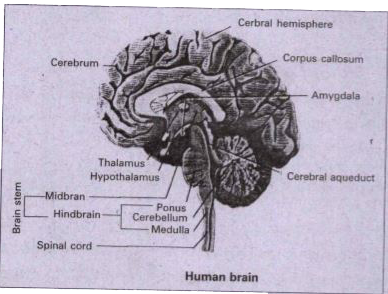Give a brief account of the structure and functions of the brain of man.Solution in Telugu
Brain is the site of information, processing and control. It is protected in the cranial cavity and covered by three cranial meninges namely durameter (outer layer), arachnoid mater (thin middle layer) and piameter (inner layer).
The brain can be divided into three major parts called
1) Fore brain
2) Mid brain
3) Hind brain
1) Fore brain : The fore brain consists of i) Olfactory bulb ii) Cerebrum and iii) Dience-phalon.
i) Olfactory bulb : Which receives impulses pertaining to smell from the Olfactory epithe-lium.
ii) Cerebrum : Cerebrum forms the major part of the human brain. A deep eleft divides the cerebrum longitudinally into two halves, which are termed as the left and the right cerebral hemispheres. The hemispheres are connected by a transverse, wide and flat bundle of myelinated fibres beneath the cortex, called corpus callosum. It brings the coordination between the left and right sides of the hemispheres. The surface of the cerebral cortex shows many folds and grooves. The folds are called gyri, the deepest and shallower grooves between folds are called fissures and sulci respectively.
The cerebral cortex contain three functional areas called
a) Sensory areas : receive and interpret the sensory impulses.
b) Motor areas : which control voluntary muscular movements.
c) Association areas : which are neither clearly sensory nor motor in function, they deal integrative functions, such as memory and communications.
The cerebral medulla consist of mostly myelinated axons. Each cerebral hemisphere of the cerebrum is divided into four lobes namely frontal, parietal, temporal and occipital lobes.
iii) Diencephalon : It contains three main parts namely, a) Epithalamus, b) Thalamus and c) Hypothalamus.
a) Epithalamus : It is the roof of the diencephalon. It is axon nervous part which is fused with the pia matter to form the anterior choriod plexus. The epithelium of the epithalamus forms a pineal stalk, which ends in a rounded structure called pineal body.
b) Thalamus : It lies superior to the mid brain. It is the major coordination centre for sensory and motor signalling.
c) Hypothalamus : It lies at the base of the thalamus. The hypothalamus forms a funnel shaped downward extension called infundibulum, connecting the hypothalamus with the pituitary gland. It also contains a group of neuro-secretory cells, which secrete hormones called hythalamic hormones.
Hypothalamus controls and integratesthe activities of the autonomous nervous system and it has osmoregulatory, thermoregulatory, thirst, feeding the satiety centres.
Limbic system : The inner part of cerebral hemisphere and group of associated structures forms limbic system. Limbic system along with hypothalamus is involved in the regulation of sexual behaviour and expression of emotional reactions.
2) Mid brain : Mid brain is located between the thalamus of the fore brain and pons varolii of hind brain. The ventral portion of mid brain consists of a pair of longitudinal bands of nervous tissues called cerebral peduncles. The dorsal portion of the mid brain consists of four lobes called corpora quadrigmina. Thw two larger anterior posterior lobes are called inferior colliculi and are concerned with auditory functions.
3) Hind brain : The hind brain comprises of cerebellum, pons varolii and medulla oblongata.
i) Cerebellum : It is the second largest part of the brain. It consists of two cerebellar hemispheres and a central vermis. Each cerebellar, hemisphere consists of three lobes namely anterior, posterior and floccular lobes. It has a branching tree like core of white matter called arbor vitae.
ii) Pons Varolii : It consists of nerve fibres which form a bridge between the two cerebellar hemispheres. It is a relay station between the cerebellum, spinal cord and the rest of the brain. Pons has the pneumotaxic centre as it regulates the amount of air a person can take in each time.
iii) Medula Oblongata : It is the posterior part of brain. It extends from the Pons Varolii above and continuous with the spinal cord below. Medulla includes cardiovasicular, and respiratory centers, the centers for swallowing, vomitting, coughing, sneezing and hiccupping. The mid brain, pons and medulla oblongata are collectirel referred to as brain stem.

Topper's Solved these Questions
- NEURAL CONTROL AND CO-ORDINATIONBOOK - VIKRAM PUBLICATION ( ANDHRA PUBLICATION)CHAPTER - NEURAL CONTROL AND CO-ORDINATIONEXERCISE - SHORT ANSWER QUESTIONS
5 Videos
- MOLECULAR BASIS OF INHERITANCE BOOK - VIKRAM PUBLICATION ( ANDHRA PUBLICATION)CHAPTER - MOLECULAR BASIS OF INHERITANCE EXERCISE - Exercise
24 Videos
- ORGANIC EVOLUTIONBOOK - VIKRAM PUBLICATION ( ANDHRA PUBLICATION)CHAPTER - ORGANIC EVOLUTIONEXERCISE - SHORT ANSWER QUESTIONS
7 Videos
Similar Questions
Draw a labelled diagram of the T.S. of the spinal cord of man.
View SolutionGroup the following as nitrogenous bases and nucleosides: Adenine, Cytidine, Thyrnine, Guanosine, Uracil and Cytosine.
View SolutionWrite a bref note on Homologos and analogous organs.
View SolutionGive an account of structure and function of xylem.
View SolutionGive a brief account of cartilage.
View SolutionGive a brief account of opiates.
View SolutionGiven an account of structure and functions of hind brain.
View SolutionGive an account of the function of human brain.
View SolutionGive brief account of nature and structure of cellulose .
View SolutionGive an account of structure and functions of hind brain.
View SolutionGive an account of the hind brain in man.
View SolutionWrite in brief the structure of human brain.
View SolutionGive a brief account of viruses with respect to their structure.
View SolutionGive a brief account of Dinoflagellates.
View SolutionGive a brief account of Prothallus.
View Solution
